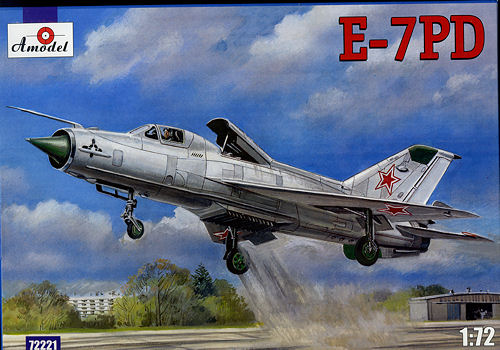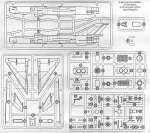
| KIT #: | 72221 |
| PRICE: | $32.99 SRP |
| DECALS: | One option |
| REVIEWER: | Scott Van Aken |
| NOTES: | Short run kit |

| HISTORY |
Have to resort to the kit instructions for this. One thing I did find out is that this aircraft is probably more correctly called the Ye-7PD or the MiG-21PD
"In September 1962, the design bureau OK-155 started to design a new MiG-23PD aircraft. The development of the fighter started after the CPSU Central Committee issued a decree, under which such variants had to be considered: the aircraft powered by the RD-36-35 lift engines and by the R21F-300 and R27F-300 power jet engines. The MiG-21 PFS was modified into the experimental Ye-7PD to test the engines. The fuselage became 900 mm longer to house the two jet lift engines mounted after the cockpit. The Ye-7PD made its maiden flight on 16 June 1966. The Ye-7PD (23-31) aircraft demonstration at the Domodedovo Air Parade in 1967 was its moment of glory. Tested takeoff and landing device found use in the Yak-38 aircraft. After the researches were finished, the 'MiG' was given to the Airplane Design Department of the Moscow Aviation Institute as an educational aid."
If you have the Yefim Gordon tome on the MiG-21, there are several pages and color photos of this aircraft included within.
| THE KIT |
 From the look of things, Amodel took a MiG-21 kit and supplied new sprues for
the fuselage and for the bits around the lift engines. However, I am pretty sure
that all the sprues are dedicated to this kit as there are some bits on most
sprues that are not typical MiG-21, like the long cable ducting fairings along
side the fuselage. The molding is really quite good, though there is a bit of
flash that will need to be taken care of.
From the look of things, Amodel took a MiG-21 kit and supplied new sprues for
the fuselage and for the bits around the lift engines. However, I am pretty sure
that all the sprues are dedicated to this kit as there are some bits on most
sprues that are not typical MiG-21, like the long cable ducting fairings along
side the fuselage. The molding is really quite good, though there is a bit of
flash that will need to be taken care of.
The surface detailing is admirably crisp and the sprue gates are small. Some of the thicker parts, like the forward fuselage where there are alignment stubs for the fuselage, have sink areas that will need to be filled. The sprue gates are admirably small, but on some parts, such as the long and thin cable ducting, the gates invade the part and will need to be sanded away once the part is removed.
A basic cockpit is provided that consists of a tub, seat and control stick. The instrument panel and area behind the seat are separate and join onto the fuselage proper. Lift engine faces are well done and on can pose the upper door open. The lower doors are molded open. I found it interesting that the nose gear well is a box with a separate upper piece. All of the various scoops and fairings are separate pieces with no area on the fuselage delineated for exactly where they go. Landing gear is quite adequate for the kit. I do not think it needs nose weight as none is indicated, but I am gun-shy and will add some.
![]() Instructions are well drawn and provide color information with Humbrol and
generic color names. As is typical of Soviet aircraft of the time, this one is
bare metal and red stars. Photo calibration marks are also included. You get
eight stars but only need six of them. Amodel decals are quite matte and my
experience with them is that they are OK, but best replaced with aftermarket if
one can. Not likely with this aircraft, though there are insignia sheets that
might prove useful.
Instructions are well drawn and provide color information with Humbrol and
generic color names. As is typical of Soviet aircraft of the time, this one is
bare metal and red stars. Photo calibration marks are also included. You get
eight stars but only need six of them. Amodel decals are quite matte and my
experience with them is that they are OK, but best replaced with aftermarket if
one can. Not likely with this aircraft, though there are insignia sheets that
might prove useful.
| CONCLUSIONS |
This is an interesting prototype that any MiG-21 fan will want to have. Amodel kits are not for the beginner, but if you do not mind a bit of a challenge and can handle bare metal, they will result in a most worth-while model for your shelves.
| REFERENCES |
Kit instructions
November 2012 Thanks to me
for the preview kit. If you would like your product reviewed fairly and fairly quickly, please
contact
the editor or see other details in the
Note to
Contributors.